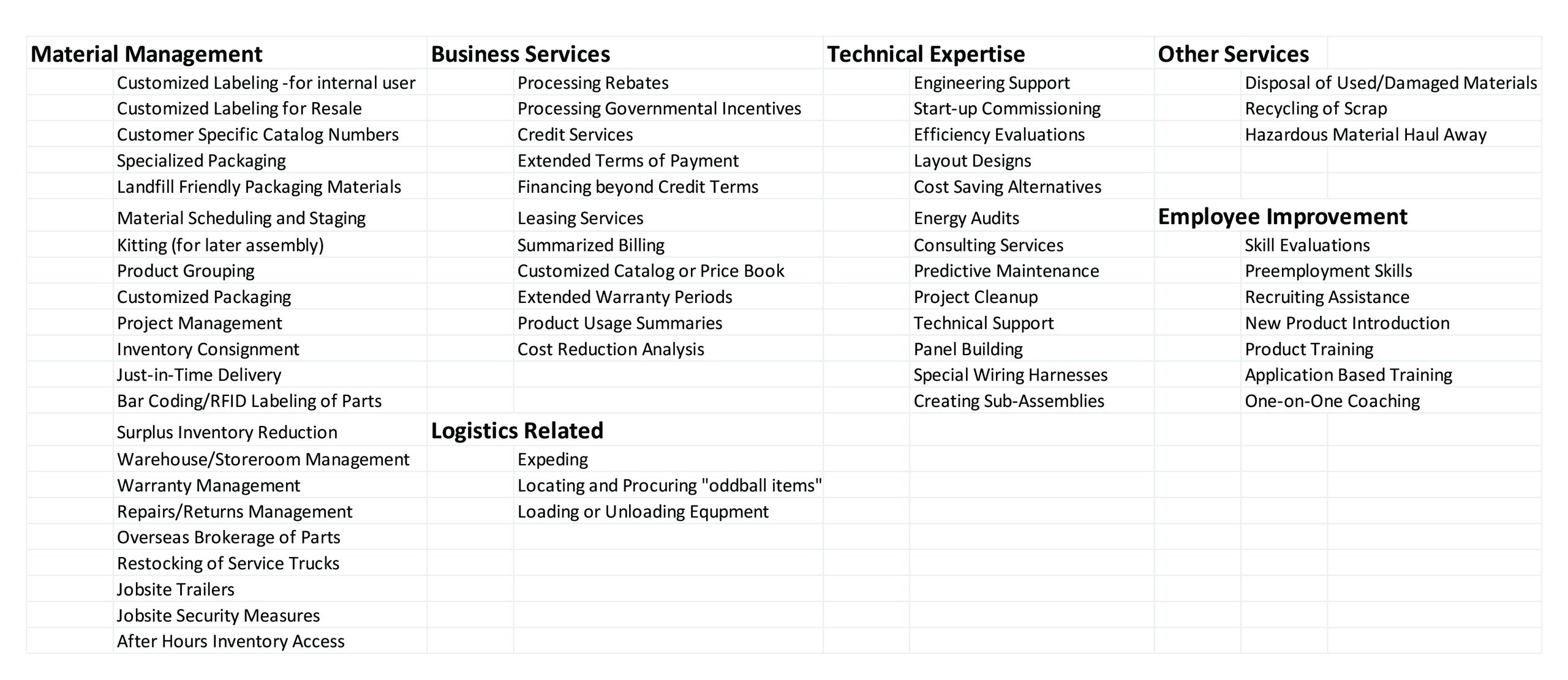For as long as I can recall, there have been folks conjuring up stories of boogiemen set to pounce on unwary distributors. Just for fun, here are some of the best scary stories:
Circa 1985: Breakthroughs in shipping provided by UPS and FedEx will obsolete local distribution.
Circa 1995: Disintermediation created by communications breakthroughs will eliminate the need for a distributor-centric supply chain.
Circa 1999: The Y2K collapse will wipe out distributor ERP systems and end the world as we know it.
Circa 2010 (and on): Jeff Bezos and his pals at Amazon have their knives and forks ready to eat distributors’ lunch.
Circa 2020: COVID-driven changes in the way customers work.
I believe the last two may harbor some threat. The combination of Amazon and COVID has changed the world. Thankfully, distributors have responded. According to my research outlined in “The 2022 State of Distributor Sales,” most have added a webstore and continue to improve their online positioning. Further, most see services as a key differentiator in the battle with Amazon-like companies.
Services should be viewed as falling into two major categories
To better understand what this service strategy is, we should think of services in a couple of ways. First, services that any reasonable customer might expect from a distributor—think of these as the “table stakes” required to be in business. Examples include order entry, standard shipping, inventory, product expertise and, in a growing number of situations, online ordering.
The second category contains services provided by the distributor to make the customer’s life better. These services include system-driven things like summary billing, usage summaries and advanced expediting. They also include more advanced services that require human interface. Services that involve/require a person from the distributor to be involved are a natural barrier against Amazon and other solely online companies.
Services may be provided by salespeople but only those who perform non-selling services. Think about this: We used to argue that our salespeople carried a lot of value in our customers’ eyes. Post-COVID research indicates customers are now far less reliant
on salespeople in the selection of even the most technical of products. Add to this situation the new breakthroughs in artificial intelligence (AI) being rapidly deployed onto major web-only competitors’ sites. AI may soon be able to assist in answering all but the most specialized questions. Sounding a bit like some of the scary headlines shared earlier, the situation for a distributor selling only products is bleak.
Channeling the 1960’s TV commercial for a new breakfast cereal, “What’s a mother to do?” based on our latest research, the answer is bundling your products in services that require real people to perform. Pausing for a moment, I cannot see a time in the foreseeable future when Amazon and their ilk will be able to incorporate customized and/or people-based services into their offering. Based on my own observations in trying to reach a live human being to resolve an issue, I suspect they go out of their way to keep people out of their business.
If your service is special and difficult to replace and the customer cannot easily duplicate it, a fee should be attached.
I would like to invite you to join me as we explore strategies for building service-oriented Amazon-proof barriers around your business.
Take inventory of the services you provide
The typical distributor provides their customers with dozens of services. Experience dictates most of them were developed based on the specific needs of a single customer and then migrated throughout the customer base. In many instances, they came with no predefined strategic thought and were simply rolled to other accounts without a longer ranging plan.
The list below comes from a brainstorming session with a group of electrical distributors. As the list was created, most of the distributors participating had no predefined service list. As new services were mentioned they simply nodded along, commenting “we do that” as additional offerings were discovered by the group.
In addition to not having a master list of services, very few of the distributors could answer the following important questions:
- How much does the service cost to provide?
- Which customers are using your services?
- Do these customers generate enough profit (not gross margin) to warrant your services?
- Which services are strategically important to future business?
- Who controls/manages the flow of services and decides who gets services in your territory?
Several years ago, I met with the management team of a distributor and asked it something akin to the final question. The answer didn’t surprise me, but the way they answered left a lasting impression. The company vice president of sales said, “We have more rules tied to who gets one of our $40 company jackets than we do for who gets $1,000 worth of our service.”
Apply financial metrics to your services
First an understatement, distributors exist both to provide both services to their customers and, more importantly, to create a profit. The good ones are constantly working to reduce their cost of operations and improve their profit picture. At the same time, few have a solid financial understanding of the costs associated with the services they provide. This creates a situation akin to selling products without understanding the cost of goods sold—not good.
Like other pieces of the distributor process, the process around services needs to be refined. Can the service somehow be delivered for less cost, or can the service be improved in a way that increases the value customers place on it? Finally, does the customer really appreciate the service?

How do your services impact the customer?
For a service to be meaningful, it must provide a positive impact for the customer. Even more importantly, the customer must understand the impact and place a value on your work. If you don’t understand your value, does it make sense to just assume the customer does, at least without a bit of coaching from your team? Understanding customer value is critical.
Apply these Eight Drivers of Value to your customer situation:
- Replacement or reduction of internal labor.
- Reduction in external labor or services purchased from others.
- Reduction in expenses, for example less energy usage, less scrap or fewer raw materials consumed.
- Reduction of assets required to carry out their work.

- Increases in revenue or product output.
- Improvement in market position.
- Safety and workplace improvement.
- Enhancements to company culture.
Many of your services may affect more than one of these drivers. For example, if you provide electrical wire that is cut to the proper length and paralleled, you are impacting both internal labor and probably reducing expenses because the customer will have less wasted scrap.
If the actions of your services don’t fall under any of the headings above, there is a good chance you are wasting money on a service that carries no real value.
If you discontinued your service, what would the customer do?
First, the customer might decide to discontinue the service, deciding whatever you were doing wasn’t important enough to assume themselves or outsource to another. This implies whatever you were doing has no value. These services are a waste of your time as are the effort and cost associated with providing them.
Second, the customer could decide to hire additional staff to handle the tasks provided by your service. This means they need to find and maintain specialists who perform the service in house and purchase any specialized tools and equipment to facilitate the service. This costs money and detracts from their core business.
In another scenario, the customer decides to hire another company to carry out the service. For example, their new partner would be an engineering firm or systems integrator for anything technical in nature. These companies are not “bundling” services and products so there would be a definite fee tied to the service.
Finally, consider the distributor’s agonizing fear that the customer will call the guy down the road, and they would lose business. Would the competitor be able to produce the same results? Often this is not the case.
Who gets the service for free and who doesn’t?
Strategically, there may be a select group of services the guy down the street can provide as well as your organization. At this point, the ball falls squarely in the distributor’s court. Does the customer’s profit contribution warrant the cost of providing the service? If the answer is yes, then continue the service without a fee. If the answer is no, the wisest business decision may be to either discontinue providing the service and let the customer find a different solution or escalate the customer to a fee-based model.
If your service is special and difficult to replace and the customer cannot easily duplicate it, a fee should be attached. Even major customers would be asked to share in the cost of the service, regardless of the customer’s volume and profit contribution.
Market your services
Earlier, we shared that many of the distributors we interact with don’t know or understand the full extent of their service offerings. Those with services listed on their websites or sales literature, don’t turn these lists of services into real sales collateral. It is important to demonstrate how your services and the value your services deliver to customers better than the competition.

If services are to be a barrier built between your customers and Amazon and other online-only organizations, your salespeople need to understand how to weave services into their customer communications. Currently, most don’t have deep skills tied to selling services. This means sales training that extends beyond the product information taught by our supply-partners.
Why I like fee-based services
For the past five years, I have beat the drum for distributor
fee-based services. I even published a manifesto on the topic (it’s on Amazon). Here are four reasons why I feel so strongly:
- Distributors have been under constant margin pressure for the past three decades. Most believe this phenomenon will continue.
- The cost of the qualified people who currently provide a plethora of our services continues to escalate. Demographic trends point to more of the same in the future.
- Tying a fee to at least some services operates as a tool for improved professionalism in the services we provide. Our people think differently when they are being compensated for the work they do.
- Finally, adding a fee to at least some services forces distributors to better evaluate the value they provide to customers. Understanding the financial impact of services provided allows you to think more strategically about future services and how they tie customers to your organization.
A parting thought:
Your services are the ultimate differentiator
When you provide essential services to your customers, they view you differently. Customers see you as an ally in their efforts to run their organizations more efficiently and effectively. Your visibility rises from the technical and price-driven buyer into the customer’s leadership team. Distributors with strong ties to those responsible for creating a profit are positioned well for the long-term future.
We have many materials on the services arena that are yours for the asking. Reach out and we can connect you with some of the research done on the topic or go to the Distribution Strategy Group and download the whitepaper I generated for them.